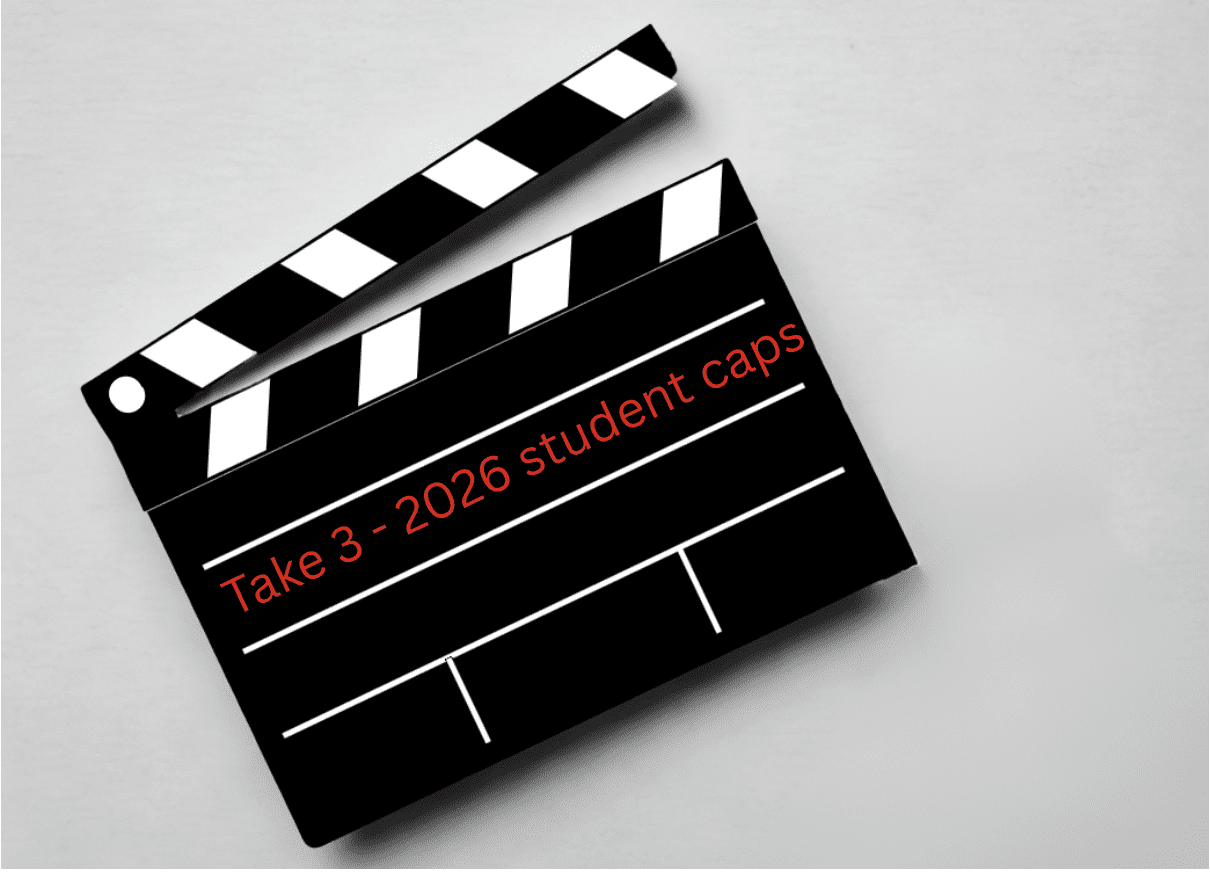
The reference to ‘Take 3’ in the image refers to Claire’s 2024 posts (Takes 1 and 2) which unpacked the 2025 international student caps
Unpacking the 2026 student visa caps
Last week the Department of Education provided a briefing to the sector which included some insights into the effectiveness of the 2025 international student caps (new overseas student commencements, NSOCs) and explained their thinking on the 2026 caps.
The Department’s presentation included the following details:
- new overseas students who have commenced study in 2025 are at 77% of the national planning level (NPL), ie the overall cap for new international students set by the government
- higher education is at 83% and
- VET at 60%
- the pipeline of ‘indicative NOSCs’ for 2025 is at 96% of the NPL
- higher education is at 105% and
- VET is at 79% (and with the continuous enrolments offered by some VET providers the Department expects both sectors to “track close to the NPL”
- 259 providers have reached the 80% visa prioritisation threshold set in Ministerial Direction 111, including:
- 26 of 38 publicly-funded universities
- 5 of 16 TAFEs
- 75 of 140 other higher education and dual-sector providers
- 153 of 977 VET providers (including 128 of the 762 VET providers with allocations of 100 or less)
I have analysed the provider-level caps set by both the Department of Education (higher education) and the Department of Employment and Workplace Relations (VET), noting that caps for publicly-funded universities are still being negotiated.
My analysis identifies some additional details not included in the official presentation.
Higher education
- 138 providers had their caps increased – including all dual-sector TAFE Institutes and private universities.
- 84 providers which had their caps increased – had an increase of 10% or less.
- 33 providers had their caps increased by 400% (all moving from 10 to 50 new students).
- The remaining 21 providers which had their caps increased typically had small caps in 2025. Notably though:
- Bond University saw its cap increase from 360 to 800 (+122%), and
- Monash College increased from 300 to 710 (+137%).
A few pathways providers, including two owned by public universities, had their caps reduced or removed entirely (ie they won’t enrol new international students through these entities in 2026). These change appear to be partly due to the correction of some errors in how the original caps were set (eg Canning College, an RTO which offers a non-AQF pathways course for Western Australian universities, was given 120 higher education student places in 2025 and it was removed from the list of higher education providers in 2026 but still has a VET cap available). Other reductions probably reflect decisions taken between universities and their pathways partners.
One private HEP whose registration expired at the end of 2024 was given an allocation of 30 places in 2025 and these have been reallocated for 2026.
There were seven providers which did not receive caps in 2025. They were each given 50 new students each for 2026.
Collectively private universities and non-university higher education providers will be able to enrol an additional 3,275 new students in 2026 compared with the total cap for these providers in 2025.
VET
TAFE Institutes were not given an increase in their caps for 2026. This decision was explained in the documentation provided by DEWR as being because Ministerial Direction 111 specifies that TAFE Institutes have priority visa processing for all of their student visa applications, unlike other providers which have priority processing for only the first 80% of their student visa applications relative to their cap.
The Department’s rationale does not explain why TAFE Institutes did not receive a higher cap for their VET students when:
- TAFE Institutes which are dual-sector providers got an increase in their caps for their higher education students
- one dual sector university (RMIT) was given an increase in its VET cap, and
- international education agents and providers speaking at the PIE Live Asia Pacific conference stated that in many instances they have not noticed any slowdown in visa processing after providers get to their 80% level.
Looking at the non-TAFE providers – DEWR categorises them according to the size of their 2026 caps.
There is one group (222 VET providers) with a cap of 101 new students or more, and another group of 702 providers with a cap of 100 or fewer new students.
None of the 702 smaller providers[1] have been given an increase in their cap for 2026 but in the government’s briefing to the sector last week, officials noted that some of these providers will be able to increase the number of new students they enrol because the places available for these small providers will be aggregated and priority visa processing will be available for providers up to 80 NOSC.
All but one of the 222 larger non-TAFE providers have been given an increase in 2026 of 5-6% on their 2025 caps.
In total the larger providers will be able to enrol 3,400 additional new international VET students in 2026 and stay within their caps.
BUT – the total increase in new international VET students next year will only be 272 extra students.
This is because in 2025 DEWR allocated caps to providers which ASQA had cancelled, to dual-sector providers which did not have CRICOS approval for their VET courses, and there were other anomalies identified in the original cap allocations.[2] In 2025 there was also a closure of a large provider (IH Training Services) and its cap has been reallocated to other providers. For 2025 DEWR also ‘held’ 4,000 NOSC places to allocate to the new CRICOS providers it expected to be registered that year and it had a further 4,560 places available to newly registered CRICOS VET providers.
In 2026 the Department will still withhold a portion of places to allocate to newly registered CRICOS providers, but many of these places in 2025 were unused and they have now been allocated to larger VET providers.
Providers appealing ASQA decisions to cancel/not renew registration
Seven of the eight providers identified in the 2025 list, which had lodged appeals against ASQA decisions to cancel or not renew their registration, have been given caps in 2026. This is despite (in most cases) the Administrative Review Tribunal allowing the ASQA decision to be stayed while it hears the appeal – on the basis that the RTO not enrol any new students. In total more than 1,300 places have been allocated in 2026 to these providers.
Exemptions from the national planning level
In addition to the categories of students exempt from the student visa caps in 2025 (eg school students, standalone ELICOS, Australian government sponsored students, etc) the following students will also be exempt from the national planning level (caps) in 2026:
- students transitioning to universities or other providers from schools in Australia
- students transitioning to publicly-funded universities from recognised pathways providers and TAFEs, and
- students transferring to another provider because their initial provider has closed or is otherwise unable to deliver training.
Summary
What does it all mean?
Well it partly depends, as Prof. Andrew Norton from Monash University points out, if there continue to be no penalties for providers which exceed their caps (when Ministerial Direction 111 is updated).
Anecdotally it is understood that eight universities have exceeded their 2025 caps and they have so far suffered no repercussions. In part this is due to the fact that the caps are simply referenced in a direction from the Minister of Home Affairs to his Department on the priorities they should give to student visa processing timelines. MD111 does not say that providers will suffer any negative consequences if they exceed these notional caps.
With education agents and providers stating publicly that where providers have exceeded their 80% limits they have not experienced any slowdown in visa processing (“we’re getting our applications approved in 3 weeks!”) it appears that the caps may be having less impact than intended.
Part of the reason why a number of providers are still getting their visa applications processed quickly (even after they exceed 80% of their cap) is because of the decline in student visa applications being lodged offshore by students who are new to Australia, meaning there are fewer student visas for the Department to process. Across both higher education and VET student visa applications are down from new students based offshore.
The unintended consequence of the various reforms the government has made has sadly been an increase in onshore student transfers – a matter much debated at the PIE Live Asia Pacific conference and well explained by Oxford International Education Group’s Neil Fitzroy in this recent article.
How the government chooses to address the sharp increase in onshore student transfers will be of keen interest to providers and students.
If the rumours are true that the government is looking to introduce a ‘student transfer fee’ of $2,500 – this will be a significant deterrent to onshore transfers, and it will also have a serious impact on genuine students who want a different/better study option with a new provider.
———————————————————
[1] ‘Smaller’ in terms of their CRICOS student numbers, some of these providers may educate large numbers of domestic students.
[2] I identified these anomalies in these previous posts:
https://clairefield.com.au/unpacking-the-international-student-caps-for-each-provider/
https://clairefield.com.au/more-problems-in-how-international-student-caps-have-been-allocated/
https://clairefield.com.au/senate-committee-hearing-into-student-caps/
https://clairefield.com.au/update-on-my-analysis-of-the-international-student-caps/




